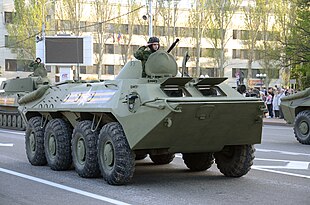| BTR-70 | |
|---|---|
 BTR-70 on parade in Donetsk, 2015 | |
| Type | Armoured personnel carrier |
| Place of origin | Soviet Union |
| Service history | |
| In service | 1972–present |
| Used by | See Operators |
| Wars | |
| Specifications | |
| Mass | 11.5 tonnes |
| Length | 7.535 m |
| Width | 2.80 m |
| Height | 2.32 m |
| Crew | 3 (+7 passengers) |
| Armor | 9 mm (front) 7 mm (sides) |
Main armament | 14.5 mm KPVT machine gun or 12.7 mm DShK |
Secondary armament | 7.62 mm PKT machine gun |
| Engine | 2× gasoline ZMZ-4905 120 hp (88.2 kW) (×2) |
| Power/weight | 20 hp/tonne |
| Suspension | wheeled 8×8 |
Operational range | 400–600 km |
| Maximum speed | 80 km/h, swim 9 km/h |
The BTR-70 is an eight-wheeled armored personnel carrier (Russian: бронетранспортёр, БТР, romanized: bronetransportyor, lit. 'armored carrier') originally developed by the Soviet Union during the late 1960s under the manufacturing code GAZ-4905. On August 21, 1972, it was accepted into Soviet service and would later be widely exported. Large quantities were also produced under license in Romania as the TAB-77.[1]
The BTR-70 was developed as a potential successor for the earlier BTR-60 series of Soviet wheeled armored personnel carriers, specifically the BTR-60PB, which it most closely resembled. It evolved out of an earlier, unsuccessful project known as the GAZ-50 to design a new wheeled infantry fighting vehicle on the chassis and drive train of a BTR-60PB.[2] It initially received the NATO reporting name BTR M1970.[3]
- ^ Christopher F. Foss (2001). Jane's Armour and Artillery (2002 ed.). Macdonald and Jane's Publishers Ltd. p. 496. ISBN 978-0710623096.
- ^ Institute for Defence Analyses, various (1995). Soviet/Russian Armor and Artillery Design Practices: 1945-1995. Quantico: United States Marine Corps Intelligence Agency. p. 12. OCLC 33890115.
- ^ Chant, Christopher (1987). A Compendium of Armaments and Military Hardware. New York: Routledge & Kegan Paul. p. 58. ISBN 0-7102-0720-4. OCLC 14965544.